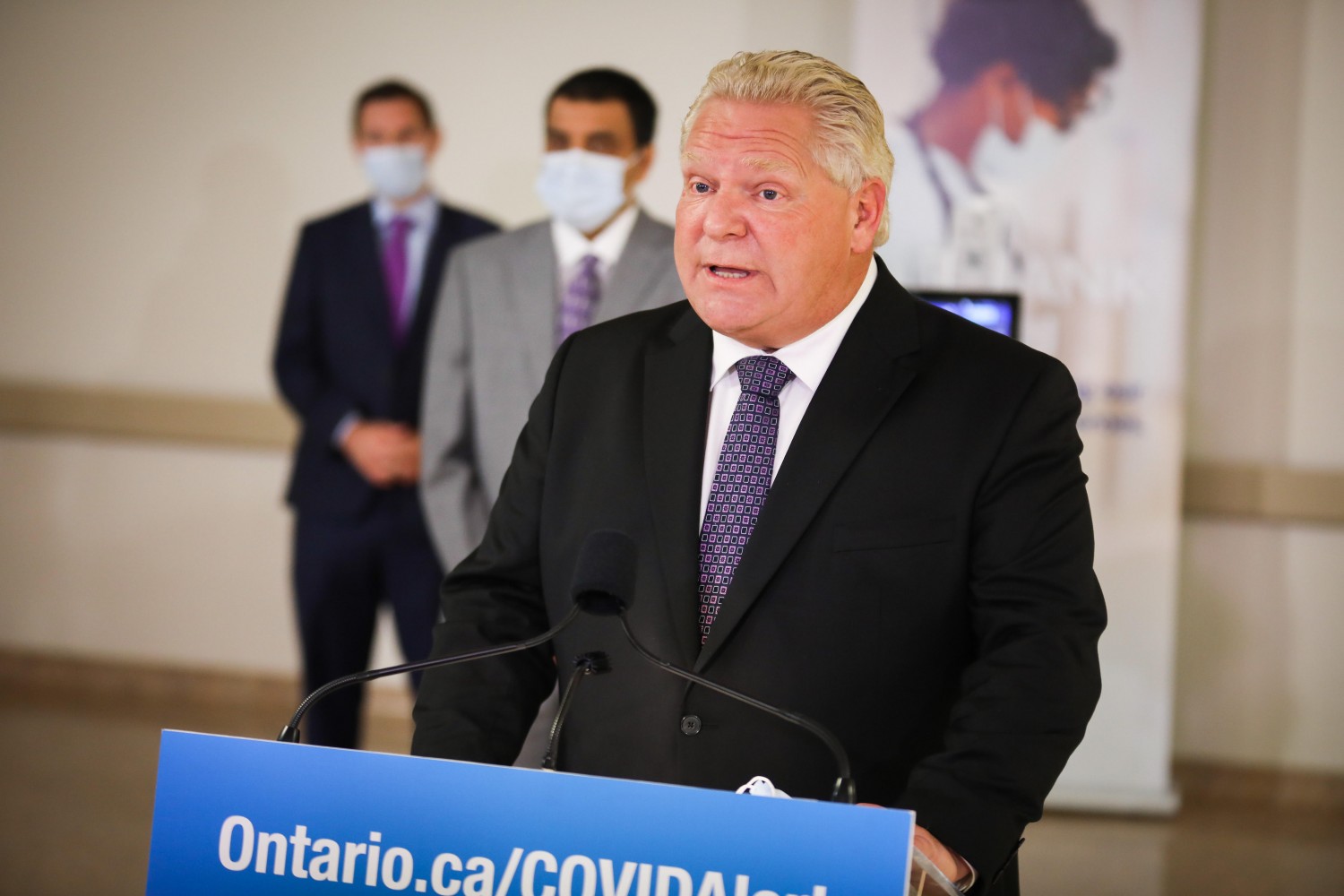
Ford and Elliott visit Brampton and once again ignore city’s healthcare crisis
“Thank you everyone. Great news for Brampton. Thank you.”
Those were the words of Ontario Premier Doug Ford as he signed off a press briefing from the Flower City on Tuesday. During the virtual announcement, he was flanked by Mayor Patrick Brown, Doctor Naveed Mohammad (President and CEO of William Osler Health System), MPP Prabmeet Sarkaria and Health Minister Christine Elliott.
Together, the collective has the power to deliver almost any change to Brampton’s beleaguered healthcare system. But the PCs have twice, since taking power in 2018, shot down a motion for a new hospital in the city.
Now, with residents crying out for proper testing capacity to mitigate the risk of COVID-19, while in the long-run a second full-service hospital is desperately overdue, all Ford could offer was a few-dozen new hospital beds.
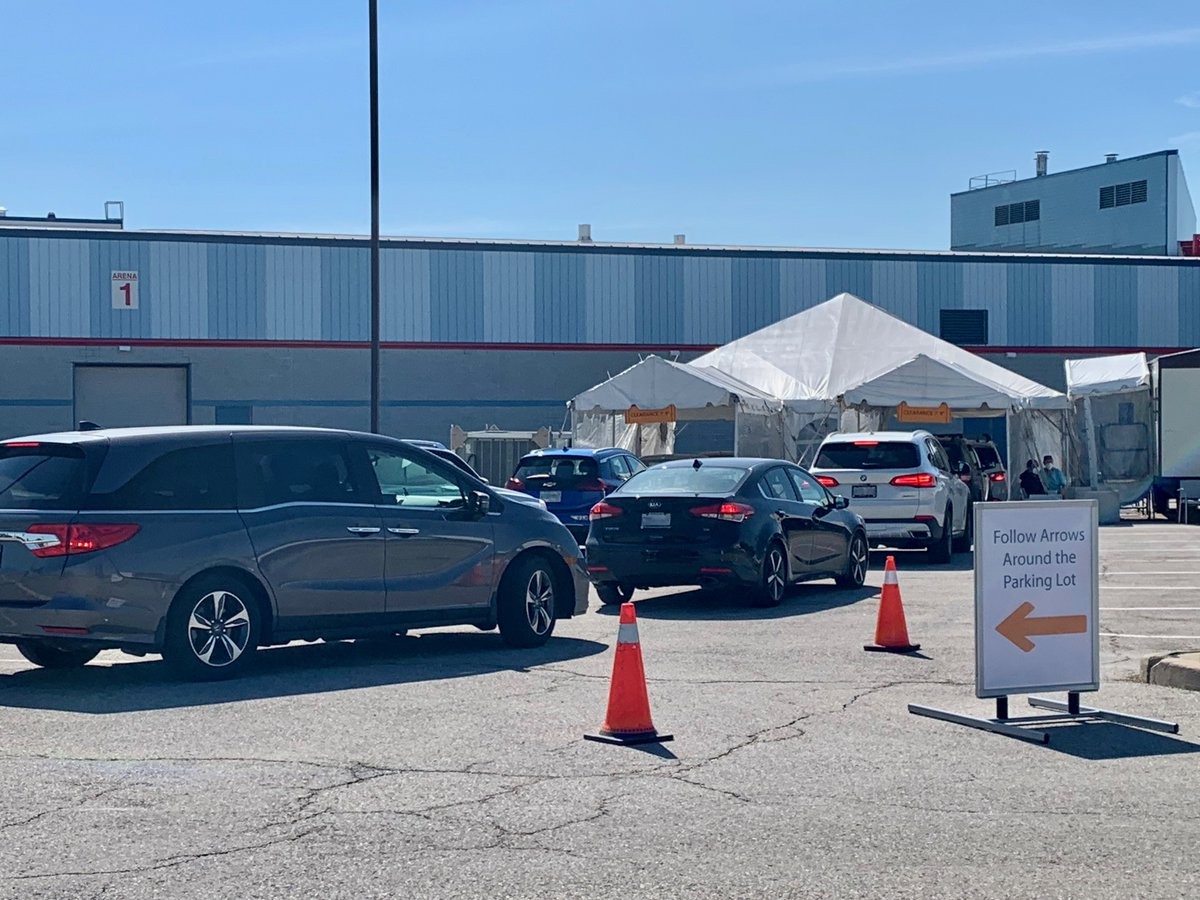
Despite being a hotspot for COVID-19 cases for months, Brampton has only had one permanent assessment centre over the course of the pandemic.
The ballooning population of Canada’s fastest growing big city was repeatedly mentioned throughout the press event.
But what the quintet of leaders failed to mention is Brampton, with 650,000 residents, has only one testing centre, and one full-service hospital. Winnipeg, with about 100,000 more residents, has eight hospitals.
The purpose of Tuesday’s virtual event was to announce the launch of additional hospital beds across the province to help accommodate a potential rise in patients as a result of the pandemic’s second wave which is surging in Ontario’s hotspots.
The Province is adding 766 beds between 32 Ontario hospitals with the aim of reducing backlogs and improving wait times.
Provincial governments in Ontario have often provided surge funding for hospitals ahead of the winter flu season, but it's unclear if Tuesday's announcement will mean a permanent allocation of hospital beds.
Etobicoke General Hospital, also run by William Osler and serving an area with roughly 365,000 residents, will receive 46 beds compared to Civic’s 41. The Etobicoke figure represents 6 percent of the total new bed announcement for an area, long associated with the Ford family and its political powerbase, that accounts for 2.5 percent of Ontario’s population. By comparison Brampton has approximately 4.5 percent of the province’s population and is only receiving 5 percent of the new beds. Civic, already chronically backlogged, leading to its unfortunate reputation as the home of hallway healthcare, will receive fewer beds to service more people than its Etobicoke counterpart, run by the same healthcare system, Osler.
Brampton has less than half the hospital beds per capita compared to Ontario overall, an average of less than one bed per 1,000 residents, compared to the Ontario average of just over 2.
In January, before the pandemic hit, City Council declared a healthcare emergency and launched a webpage where residents can directly contact their local MPP to “demand a fair deal” for Brampton. It calls for the immediate expansion of Peel Memorial, currently a preventative care facility with no in-patient beds, and a third hospital in the city.
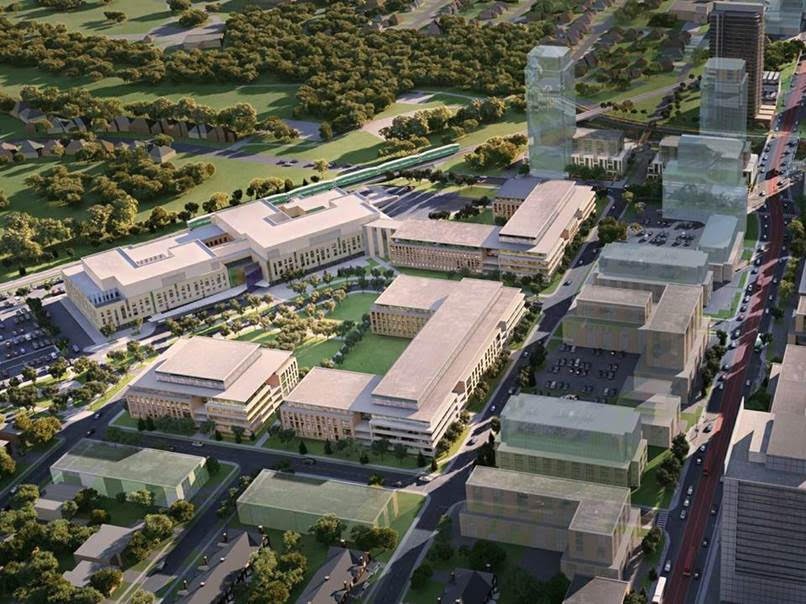
An early rendering of the full buildout for the Peel Memorial hospital. Premier Ford once again promised funding to expand the facility into a full-service hospital on Tuesday.
Both Brampton Civic and Etobicoke General have wait times of roughly 20 hours to be admitted from the emergency room, according to Health Quality Ontario’s August data. The provincial target is eight hours (Osler has one of the poorest performances in the province). Even though the two hospitals share troubling delays, provincial funding announcements for the facilities have been night and day since Ford took office in 2018.
Last year, Etobicoke General was at the heart of a major funding and infrastructure project, adding 250,000-square-feet of space to the facility. A new patient tower, opened by Ford, who represents Etobicoke North, included a state-of-the-art emergency department and 10 private birthing suites. A media release from 2016 said the tower would quadruple Etobicoke General’s intensive care capacity. After Ford took power in 2018, his government committed the $358 million for the project’s completion, and the Premier heralded it as the end of “Hallway Health Care in Etobicoke”.
The problem: during his election campaign across Ontario it was Brampton Civic that was used by his party, and the others, as the example of “hallway healthcare” in the province, because of data that had been released by the NDP.
From April 2016 to April 2017, 4,352 patients were treated in Civic’s hallways because of chronic over-capacity. A freedom of information request by The Pointer found the number decreased to 3,035 patients treated in Civic’s hallways in 2018.
But the hospital has not received the type of expansion as Etobicoke General. And now, despite its ongoing crisis, it will get slightly fewer new beds than its counterpart.
It is unclear why William Osler officials, acutely aware of the issues at Civic, would not advocate for a larger allocation of beds for Brampton.
The funding provided for the 766 beds sits at $116.5 million, $19 million of which will go to William Osler. The figure is a little higher than recent fall healthcare announcements, but not an unusual promise as the year draws to a close and winter flu season approaches.
In the fall of 2018, shortly after Ford was elected, $90 million was announced to add beds at certain hospitals around Ontario, but Civic was left off the list. A Ministry of Health spokesperson at the time, told The Pointer that Brampton residents could travel to other cities during the flu season, if Civic was overcrowded. The year before, the outgoing Liberal government provided $100 million for new beds.
In September, as the pandemic’s second wave rolled over Brampton, Civic had 17 days in code gridlock, meaning more people needed admission than the number of people being discharged to make room; seven of those days saw an extreme code gridlock.
Dr. Andrew Healey, Osler’s interim chief of emergency medicine, told the Toronto Star last month that resources at the hospital were already so stretched, long-term care facilities that needed help could not be accommodated, unlike the first wave when Osler was able to assist LTC residents.
“We are in the middle of a pandemic, and Brampton is a COVID-19 hot spot. Brampton needs so much more than the surge beds it gets every flu season,” NDP Leader Andrea Horwath told The Pointer in a statement Tuesday. “Brampton’s health care system was in crisis before the pandemic struck, thanks to years of Liberal and Conservative cuts and freezes. Brampton needs an actual commitment from the provincial government to fund a new hospital and expand Peel Memorial.”
As Horwath suggested, Brampton Civic has struggled for years. In May, figures showed the hospital had used more than 90 percent of its critical care beds and 83 percent of an expanded allocation sent in by the Province as a result of surging cases of COVID-19. The hospital, at the epicentre of Ontario’s hallway healthcare crisis, operated beyond 100 percent capacity throughout 2019, despite guidelines that state hospital capacity should not exceed 85 percent.
“I don’t understand how long a city of 650,000 people and growing can have one ER,” Chris Bejnar, a co-founder of Citizens for a Better Brampton, told The Pointer. “It’s beyond comprehension to be honest with you. The numbers are always there, everybody realizes there’s an issue, but when it comes to actually getting funding or appropriate resources, it always falls short.”
Tuesday’s extra 41 beds are unlikely to make a dent, especially if increasing numbers of COVID-19 cases and the cold and flu season combine for a potentially deadly winter.
“Thank you to Premier Doug Ford for supporting the people of Brampton throughout this pandemic and for his commitment to this region after numerous governments have failed to address the high needs of one of the fastest growing regions in all of Canada,” MPP Sarkaria said at the announcement.
Alongside PC MPP Amarjot Sandhu (Brampton West), both have failed to provide for their city’s desperate needs, and have not addressed the woeful lack of testing that continues to put residents in their city at risk.
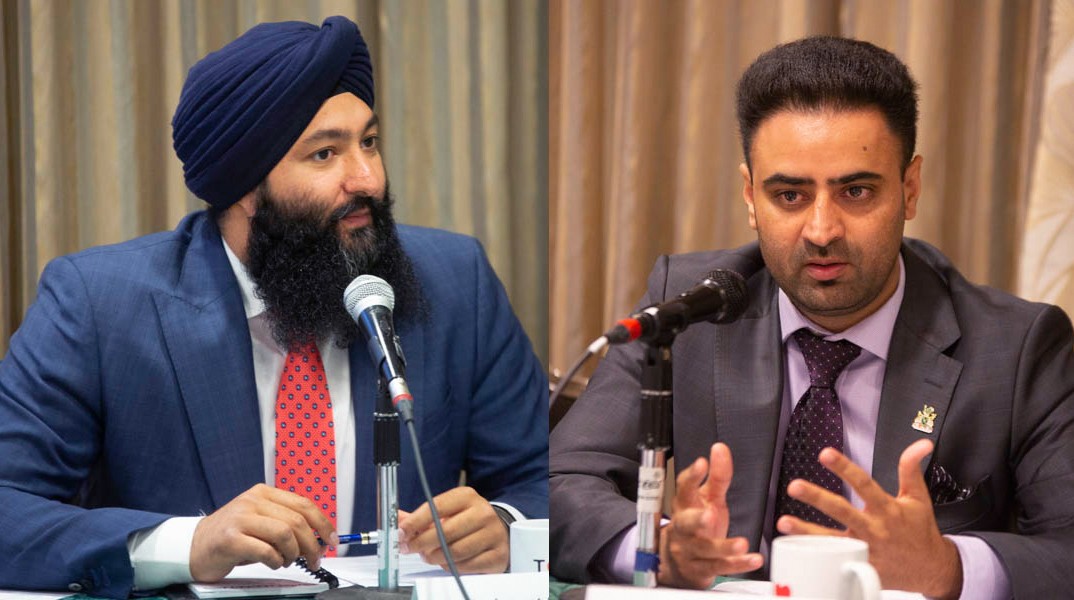
Brampton PC MPPs Prabmeet Sarkaria (left) and Amarjot Sandhu.
Neither turned up for a vote on providing Brampton with an additional hospital in 2018. After furious community backlash, the pair voted in favour of a similar motion at Queen’s Park the next year, but their party again defeated it.
During the announcement Tuesday, Ford restated his commitment to building Peel Memorial’s Phase Two, which was part of the commitment by the previous Liberal government that greenlit the wellness centre, which residents such as Bejnar want expanded into a full-service hospital.
The promise was repeated by Ford, echoing what he said early in the year, when Mayor Brown confused the Premier’s remark for a commitment to build a third hospital. In his excitement, Brown, who was at the same January police event with Ford, tweeted the news of a third hospital for Brampton, knowing how desperately it’s needed.
The tweet would need to be walked back when the Premier’s Office clarified Ford’s words were only referring to the second phase of Peel Memorial, not a third hospital.
Similarly, Ford’s words Tuesday were part of a list of previously announced commitments to Brampton highlighting his government's past investment and did not represent new plans.
“Talk is cheap. The PC Party’s voting record shows Ford isn’t committed to expanding Peel Memorial and building a new hospital,” NDP Deputy Leader Sara Singh (MPP for Brampton Centre) said in a media release.
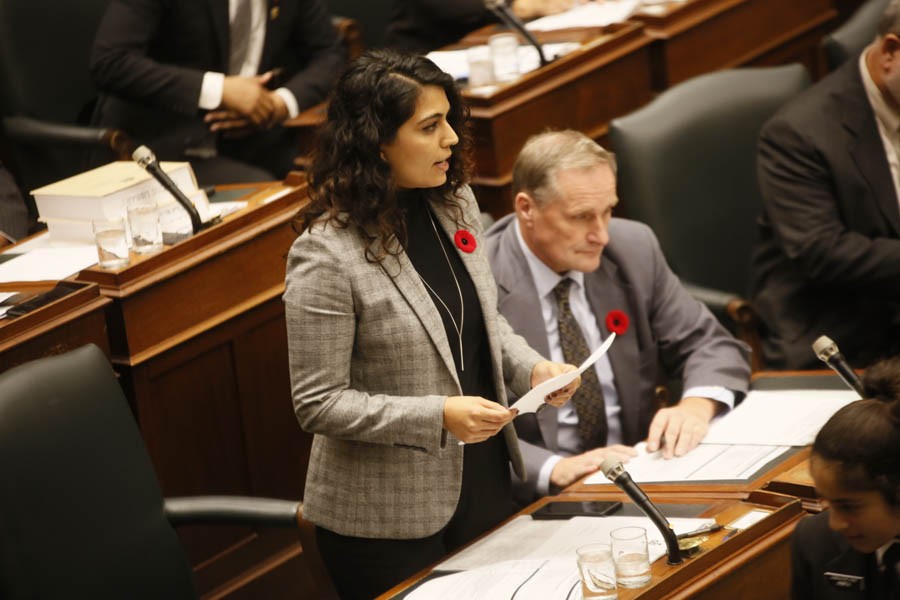
NDP Deputy Leader and Brampton MPP Sara Singh (above) and her NDP colleagues have little faith in PC healthcare announcements for Brampton, stating they will only believe the words when shovels hit the ground.
“We won’t believe any investment — in beds or an actual expansion — is coming until we see Ford commit to funding and timelines, and we see shovels actually go into the ground,” Kevin Yarde, NDP MPP for Brampton North, added. “New Democrats know exactly what we’d do if we were government: expand Peel Memorial into a full hospital, and build [another] new hospital in Brampton.”
On Tuesday, Ford and Elliott once again could not explain why Brampton has only been allotted one COVID-19 assessment centre since the beginning of the pandemic, compared to three in Mississauga.
Investigations by The Pointer have found the city falling woefully short of its share of provincial testing targets as a result. Based on an Ontario-wide target of 40,000 tests per day (using a population for Brampton of 650,000) means the city should be screening roughly 1,800 people and a little less than 2,300 to hit the Province’s daily target of 50,000. Pharmacies and Brampton’s lone test centre are completing roughly 972 tests per day. (Read the full story here).
Local and provincial health officials have failed to explain the gap. Inadequate testing has been blamed in hotspots around the world as a key reason for failing to get viral spread under control. Brampton, which is one of the worst hotspots in the country, has had very low testing levels and only the lone screening site since the start of the pandemic.
In June, Brown misled the public by claiming “our hospital” had completed the most tests in Ontario. The figures he referenced were in fact for William Osler as a whole, which then operated two testing facilities in Etobicoke, including a drive-through. At Tuesday’s briefing Brown repeated the claim, this time attributing it to William Osler as a whole.
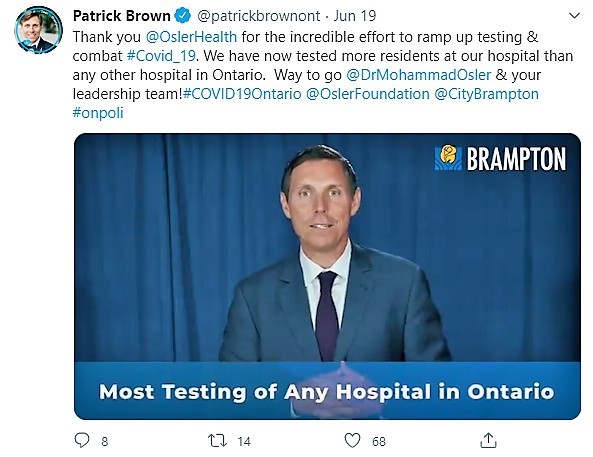
Mayor Brown has repeatedly misled residents on the amount of testing being completed in Brampton, conflating testing figures from William Osler (which includes Etobicoke test numbers) with results in his city.
Last month, The Pointer asked Elliott if she would provide a second testing centre for Brampton. Her response showed a worrying ignorance of one of Ontario’s most severe hotspots.
“If we find that there is a need for another testing centre in Brampton, of course, we will take a look at that, because we want people to go and get tested and distance from the testing facility shouldn’t be a problem that hinders them from doing that,” she said September 14.
The comment came less than a fortnight after Brampton twice accounted for almost 40 percent of Ontario’s cases. Between August 30 to September 3, Brampton accounted for 29 percent of all new cases in Ontario over the five-day period, with 177 of the province’s 603 cases. The city has been disproportionately responsible for case counts throughout the pandemic.
A previously planned test centre was opened for the “foreseeable future” at Greenbriar Recreation Centre on September 18. It was a major victory for the city, offering desperately needed capacity and one celebrated by Sarkaria, Ford and Brown on social media.
The second testing centre was open for a week, before changes to provincial testing guidelines led to it being closed. None of the three mentioned the closure.
On Tuesday, The Pointer asked Ford and Elliott if they would commit to a second, full-service drive-through testing centre. Both made reference to general testing levels across the province, the capability of pharmacies to complete asymptomatic testing and future technology as a potential for faster testing. “We’re doing more tests than anyone in the country,” Ford said.
Elliott said some areas of Peel Region had been identified for additional pop-up testing, only weeks after the province appeared to move away from pop-ups under its new criteria. Pushed on the issue, the Minister offered an outline of a similar promise to the people of Brampton, one she had suggested last month.
"We will look into what is happening in Brampton,” Elliott said. “If there aren't enough test facilities, we are in regular contact with Dr [Lawrence] Loh [Peel’s chief medical officer of health] and ... if there's a particular area where there needs to be another assessment centre, drive-through centre, we will certainly do that because as I indicated earlier, if someone needs to be tested, we want them to be able to go to a location that's close to them and receive the results in a timely manner.”
Loh told The Pointer he would continue to work with Ontario Health “to provide the data they require to determine where testing is needed,” adding he would always “advocate for testing that meets the needs of the community.” He stopped short of calling on the Province to provide a new full testing centre.
Loh only declared that Peel entered the second wave at the beginning of this week, despite the data, which shows a second wave hit Brampton in August and Peel as a whole in September. He has been reluctant to acknowledge the severity of the pandemic, recently stating he did not want to declare a second wave because he didn’t want to panic residents. It was an oddly political statement, similar to what healthcare officials south of the border aligned with U.S. President Donald Trump have been criticized for. Loh is expected to use facts, evidence and the science to offer advice, instead of making political statements that suggest he is tailoring his messaging to calm people.
Meanwhile, with another missed opportunity to invest in the future of Brampton’s struggling healthcare infrastructure, and the added frustration of more resources going to Etobicoke, residents like Bejnar feel short changed.
Elliott, like her government’s general healthcare stance toward Brampton, once again acted like she isn’t aware of the latest crisis putting residents’ safety at risk.
“I can certainly commit to you, we will look at the centres in Brampton and, if more are needed, we will certainly set them up,” she said.
Email: [email protected]
Twitter: @isaaccallan
Tel: 647 561-4879
COVID-19 is impacting all Canadians. At a time when vital public information is needed by everyone, The Pointer has taken down our paywall on all stories relating to the pandemic and those of public interest to ensure every resident of Brampton and Mississauga has access to the facts. For those who are able, we encourage you to consider a subscription. This will help us report on important public interest issues the community needs to know about now more than ever. You can register for a 30-day free trial HERE. Thereafter, The Pointer will charge $10 a month and you can cancel any time right on the website. Thank you.
Submit a correction about this story


